
AN INTERVIEW WITH JOSEPHINE MAISONET, SENSEI
By Shihan William Rivera
MartialForce.Com
Edited by Lydia Alicea
“TOTAL CONFIDENCE”

One of the most interesting aspects of meeting and writing about martial artists has to be seeing how the benefits of training and dedication follows all the way through into the person.
The result makes the individual a walking talking testament of what the martial arts can do when trained correctly. I am not just talking about the level of skill and form that can be achieved. That is always truly awesome to watch and admire, yes! I am speaking of seeing and “feeling” that end result in the artist.
We recently had an opportunity to meet with a Shotokan stylist of the World Traditional Karate Organization. She is Josephine Maisonet a multi-faceted gem of an individual of many talents and skills. Josephine is also an exceptional and accomplished martial artist with years of commitment to the art she believes in.
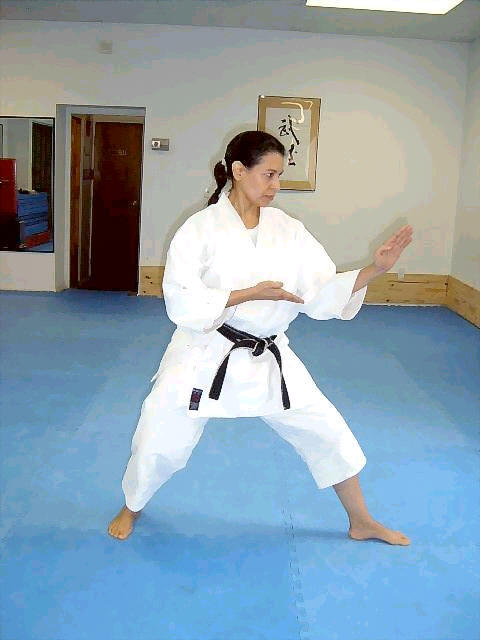
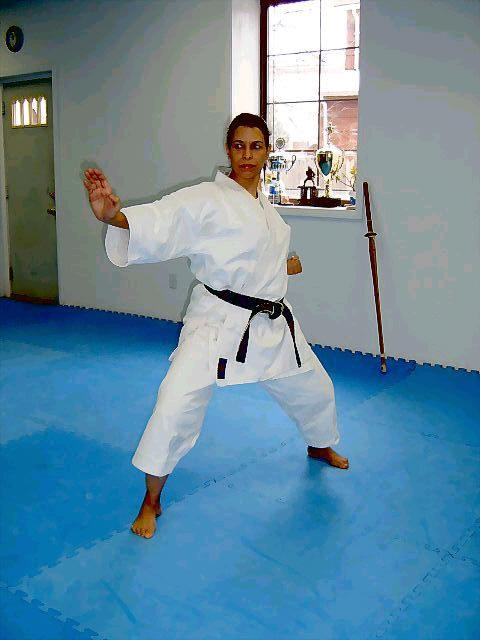
Many things about Josephine impressed us, though perhaps the most inspiring quality that came through so vividly was her total confidence. That confidence (as she will explain) from within is attained when trained correctly with patience, understanding, and respect to the art.
When a person that is capable and trusting trains an artist, the confidence gained is unlimited.
The confidence is your power to take the subsequent paths that follow not only in your martial art but also in the various parts of your life.
Think about that.
M.Force: “How long have you trained for?”
J.Maisonet: “I have trained for approximately 29 years.”
M.Force: “Tell me about your initial introduction into the martial arts. How did you become interested and why did you decide to study this art?”
J.Maisonet: “That is an interesting question. I had just begun studying at Kingsborough Community College in Brooklyn. I needed to register for an additional class for the semester. I considered a sports class because I have always been athletically active. However, what I really wanted was to take ballet, but unfortunately the class was closed for further registration. The only course available was a class in Jujitsu. With no previous martial arts training, I took Jujitsu. Not only did I pass the course I got totally hooked!”
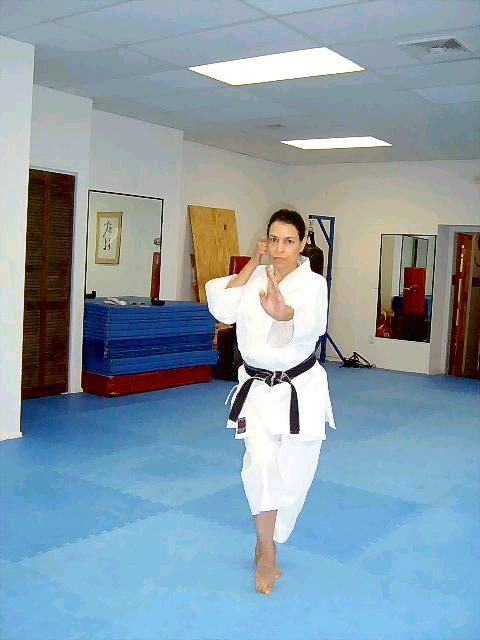

M.Force: “At some point you began training in Shotokan though your initial introduction to the martial arts was in Jujitsu. How did this come about?”
J.Maisonet: “Actually my instructor’s parent style was in Shotokan but what he was teaching at the college that semester was Jujitsu. I wanted more so the following semester I registered for the class in Shotokan. I began my studying in Shotokan with Sensei Mullin. In time, with hard work my abilities and skills progressed, and I was enjoying it! It was not too long until I realized that Shotokan was right for me. I continued my training with Sensei Mullin and became a martial artist.”
M.Force: “You served in the military, is this when you start training with weights?”
J.Maisonet: “In 1979, I signed up for the service in the Navy. I completed one tour (4 years) followed by in the Reserves. When in boot camp I learned that the martial arts were not offered as a training option. You were permitted to practice but without instruction.
This presented a problem for me because I needed to keep in shape. I began weight training to supplement the martial arts for a stronger body. I have a small bone frame.
I weight trained during the early 1980’s which at that time women were just beginning to get into bodybuilding. It was also becoming a very popular sport. It was an exciting time for me to have been I was one of the forerunners who started that whole trend of physical fitness. I was there in the beginning, training and competing in bodybuilding. We were a pioneering group of women bodybuilders that included Gladys Portuguese and Rachel McLish. ”

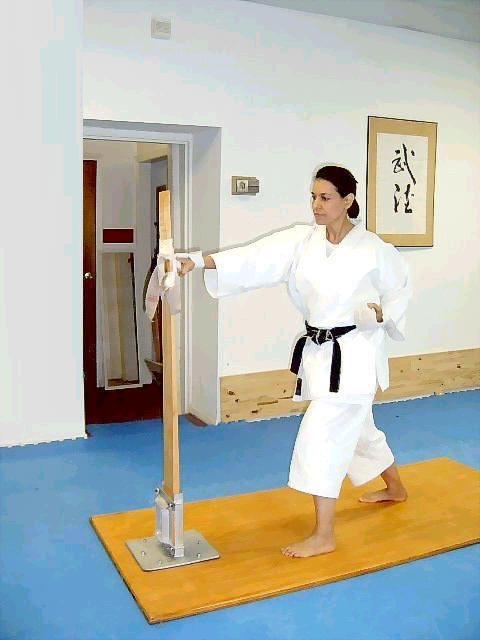
J.Maisonet: “That is such an erroneous misconception! Ask any sports doctor or knowledgeable coach. You must supplement the body with weight training specific for the activity that you are doing. I continue to weight train.“
J.Maisonet: “I am a Sandan and currently training for my Fourth Dan. I am not interested in the rank, and have not tested for 10 years. For me, rank is not the most important thing but I decided to get another one underneath my belt, good for our organization and for the dojo. My martial art is Shotokan and I continue to train because I just love doing it.”
M.Force: “Have you competed overseas?”
J.Maisonet: “No, strictly in local tournaments like the JKA North American Championships. Years ago I enjoyed competing in bodybuilding where skills were tested amongst your peers and in doing so you raised your standards. I also competed in kata and kumite, but I excelled in kumite. We do not specialize in one specifically. We encourage and train in both although a student may be stronger in one over the other.”
M.Force: “How do you deal with the fear of fighting someone heavier or bigger?”
J.Maisonet: “I do not remember having fear against an opponent because of how the person presented themselves. What I do know is that you must do what is necessary that is what the martial arts prepare you for.”
M.Force: “Is it the training? How do you teach a young girl (martial artist) for example, who is scared? How do you train someone to deal with that fear?”
J.Maisonet: “Ok, yes, that is when the training comes in. No question about it, confidence must come as a result of your training. When I competed, I knew I was well trained. I did indeed have an excellent instructor; therefore, my training gave me the confidence to correctly apply what I needed.
I think the training you receive should teach you how to draw from within. Knowing a form, a move is not enough. Instead, it is knowing how to develop your strategy when you go in the ring. That ability comes from being prepared correctly. When training for competition you work your plan. However, the key is your training.
Knowing you have been well trained = confidence. You have the ability to do something and know you will not be standing there to be a victim.”
J.Maisonet: “Not other styles of karate. I train in Aikido, and some lessons in sword. I also do Yoga. Basically, for me it is Shotokan.”
J.Maisonet: “Perhaps because everything supplements one another, it rounds out the person. For someone who is relatively physically fit the benefits of cross training can be improved flexibility, strength, and endurance. I have incorporated it in my lifestyle for so long that it is a part of me.
it is good for me but I do not obsess about it where I think I need to train 24 hours a day. No. I know that I train because it is a part of me and once done I move to the other important parts of my life”
I
J.Maisonet: “It will vary. I choose from not only what I need but also what I want. Today was a personal training day and I chose to do technique and bunkai on the heavy bag.”
J.Maisonet: “Front, sidekicks, doing the basics and fundamental techniques; reverse punches, overhead blocks, back kicks, they are all there. Stepping back and forth, doing a series then breaking it down slow and fast. I always try to understand the mechanics of the body. I work my kata breaking it down as you saw me.
For me it is important to understand the kinesiology of it all. You need to be aware of how the body works to make effort efficient and not waste energy. Concentrate on not wasting movements so it can look clean and you know where the power comes from. Doing so will allow it to stay with you and it becomes experience. Of course what is nice about experience is that you can always pass it down to someone.”
J.Maisonet: “Again, I will vary it depending on the day. It can be as little as 15 minutes or an hour. I do not allow my workout to dictate my schedule. Instead it supplements everything else I do”
(Sensei Mullin now speaking) “With Masataka Mori (Master) it was pressure filled, very crowded, where brown and black belts went last. The headquarters is located in the city, between 74 and 75 St. and Broadway. The year was about 1978. When she finally went up she did kihon up and down the floor, a lot of basics, yondon tsuki, stepping forward, shoto uke, elbow strike, back fist, reverse punch stepping backwards etc.

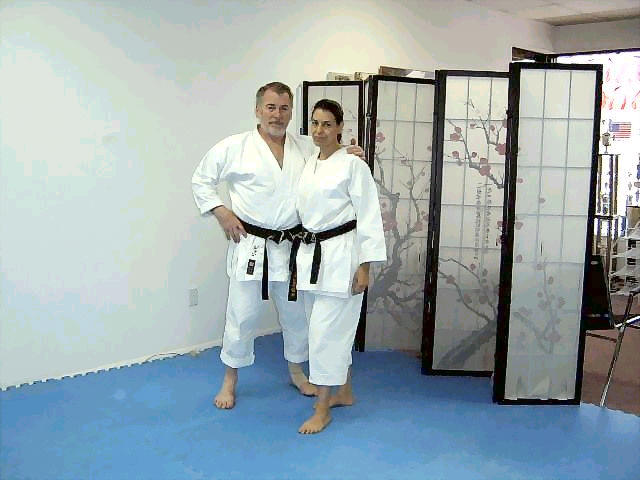
The basics probably lasted five minutes. You later threw your kicks where they looked for speed, power, and control, as well as correct hip movement. You did about 100 movements, basics, and combinations, after the kihon, you moved in front of Mori, and you moved into kata. You did your own kata (Basai Dai) and than he called a kata, though I do not remember which one. She was very strong, fast, and agile. After that, it was kumite where she shined.
Allowed for black belts it was semi free sparring, jiyu kumite. She sparred with men and handled it with no problem. She faced about three people; pressure packed everybody watching you. The actual test is about 20 minutes with much intensity. Shodan really means you have mastered the basics, you understand all your basic principles and you can apply them. You really do not start advancing to kumite level until nidan. That is when you are expected to take all the concepts you have been taught up to that point and be able to apply them to kumite and begin working on the higher kata etc.”
J.Maisonet: “Unfortunately there were no female role models at that time. In fact, when we started bodybuilding there were very few women doing this. Why did I? Because I just liked it, it was in me.”
J.Maisonet: “Good question and asked differently! The instructor does not have to beat up a student to make them tough. That approach would not have worked for me. Some students excel with the hit over the head, drive them, and force them approach. For other students, you instruct through explanations and teaching that the technique has to be worked well. I am in that category. Fortunately, Mori and John never have done that, it was always explained to me, the technique had to be a certain way, worked a certain way, work it out. The hooray way of teaching would not have worked for me. It can drive women away who feel that they are going to be banged and beat up in order to get better. That is not the whole point and that is certainly not what martial arts are about. Knowing that I could go out in the streets and can handle a situation if presented, that I could respond with something and not allow myself to be the victim.”
M.Force: “Do you feel as a woman you can counter violence if threatened? How would you respond to those who say karate does not prepare you for the reality of the street?”
J.Maisonet: “That is such as erroneous opinion that should not be voiced! Again, responding to threat is what the martial arts prepares you for. It is all about knowing how to react if you found yourself in a threatening or confrontational situation.
I would agree that much of the karate instruction taught is geared towards preparation for competition, but listen. A front kick, a punch taught correctly, still prepares you with something to respond with, and therefore is effective out in the streets. You do not need to be fancy and pretty. Knowing a punch or a front kick when someone is attacking you is the least thing your aggressor expects you know how to use. You see that I am a small woman; I do not look imposing or threatening. But, I like knowing I have what I need to defend myself with in my arsenal, with the element of surprise.”
J.Maisonet: “Kata, for me, is the form where all the hidden self-defense is in. You take it apart and understand the bunkai. That’s what kata is, the hidden fighting that makes you the warrior in the center and all your opponents are out there. Prearranged movements that take in all sorts of scenario that could happen if one would be attacked. As I stated earlier, confidence comes from being prepared”
“I cherish the many aspects of my life that makes me who I am. The Shotokan training is one, which is very important and special to me. I value my privacy; I like to have the element of surprise.
I like to analyze things. I have a degree in mathematics and computer science, so I analyze that is my background. I want to break it down for my body I have to understand it internally for myself.”
J.Maisonet: “It is perfectly fine for some women. There are those who need that type of environment. If it works in such a manner that a student can focus easier without the stress and worry confronting a male opponent might create for them while in training, great.”
M.Force: “But if you don’t train with a male opponent, possibly 6’4”, weighing 250lbs, how will you be able to handle it if confronted?”
J.Maisonet: “You are equating physical stature with strength and power, and throwing in one’s gender as well. Again, as you well know, with self-defense through martial arts training, muscle does not mean anything. You can see clearly in Aikido. There is always a way to defend oneself and it is not always about strength and brawn. It is about thinking with what you know. It is about technique and strategy and being able to assess the situation, quickly.”
M.Force: “If you train with a woman you think there lacks that feeling or pressure that a man can apply?”
J.Maisonet: “Correctly trained, you learn not to muscle but rather to use strategy, evasiveness. Training has to have the element of some intelligence and intellect. It must teach how to decide what is needed with what you have.
It is about a system of a style for the situations that arise at that moment in time. You decide what you need. Geniuses developed each martial art many years ago. They analyzed the possibilities of situations, and understood what they had.”
J.Maisonet: “I am an artist and often part of being an artist is to draw. My drawings are just one of many ways I express my creativity. I like to use pencil and charcoal a lot for my drawings and sketches. I work in both the traditional (oil, watercolor, charcoal) and digital (software such as Adobe Photoshop) mediums. As well as being an artist I professionally work as a graphic designer and web developer.”
M.Force: “What advice do you have for students who are thinking about practicing the martial arts, and those already involved?”
J.Maisonet: “Certainly. I always encourage students to continue with their training. You will develop confidence; and it is a good athletic endeavor.
Also working out is still very much encouraged. Going to the gym, working out at home, walking, weight training, and running. Just do something! However, do not allow yourself to become obsessed about training for hours until you drop. Wrong approach. Relax with it. Do your 30 to 60 minutes. Then move on to the other important things you do. I have been doing this for a very long time. You will learn that what you have must be sustainable or else you burn out and quit. Why? Because you have been working at 110% but cannot sustain that 110%.”
J.Maisonet: “John Mullin because genuinely, he is a great martial artist. He is always analyzing how to improve and make training more effective.
Together with Richard Amos, they are not satisfied with just practice. For me this is such an interesting and intelligent approach to evolving with the art. You raise your training to another level and it is not all about brute strength. If you can kick me through the door you do not necessarily need martial arts to do that, just power.
You asked me earlier how a small person could become a great martial artist. Ok, the answer is using your brainpower, your training and understanding what you need to do in making it effective. It is such a simple and pragmatic approach. I love the Martial Arts because it works and I plan to do it for the rest of my life.”
M.Force: “Since this interview has to end, tell me about your trip to Japan.”
J.Maisonet: “A quick story. Years ago I went on vacation to Japan and stayed 6 weeks training at the Honbu dojo and the Kanazawa dojo. They do not brutalize the women as they do the men. We were actually trained in a lot of technical stuff and my skills improved tremendously. Yet, I never had to prove myself, as the men have to do. The women’s approach was more civilized although we trained very hard but did not worry about brutality. There were women from all over the world but a very small percentage when compared to the men. If there were 100 who attended, less than 20 were women.”
“To Josephine, a heart felt thank you for allowing us to learn about her. A private individual who lives by what she believes in and holds what is important close to her heart, Not with brag and fanfare but by example, by doing it. (Congratulations Josephine Maisonet Sensei on passing your Yondan examination Osu!)
Thank you Sensei Mullin for introducing us to Josephine and welcoming us into your dojo.
If you want tradition and hardcore Shotokan you need not go any further than the dojo of:
John J. Mullin Sensei, Executive Chairman for the World Traditional Karate Organization located in Staten Island, New York (718) 815-5700.”